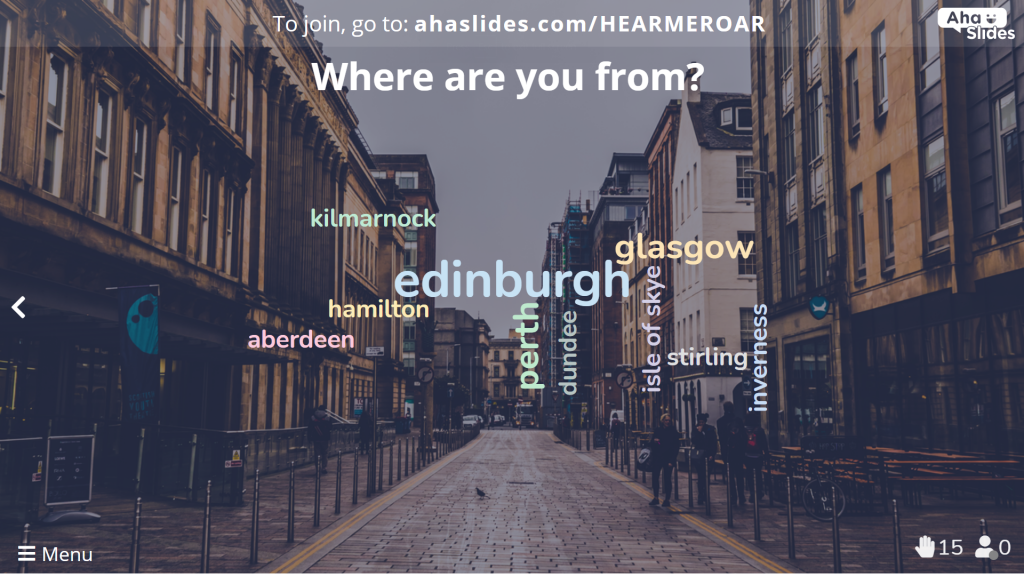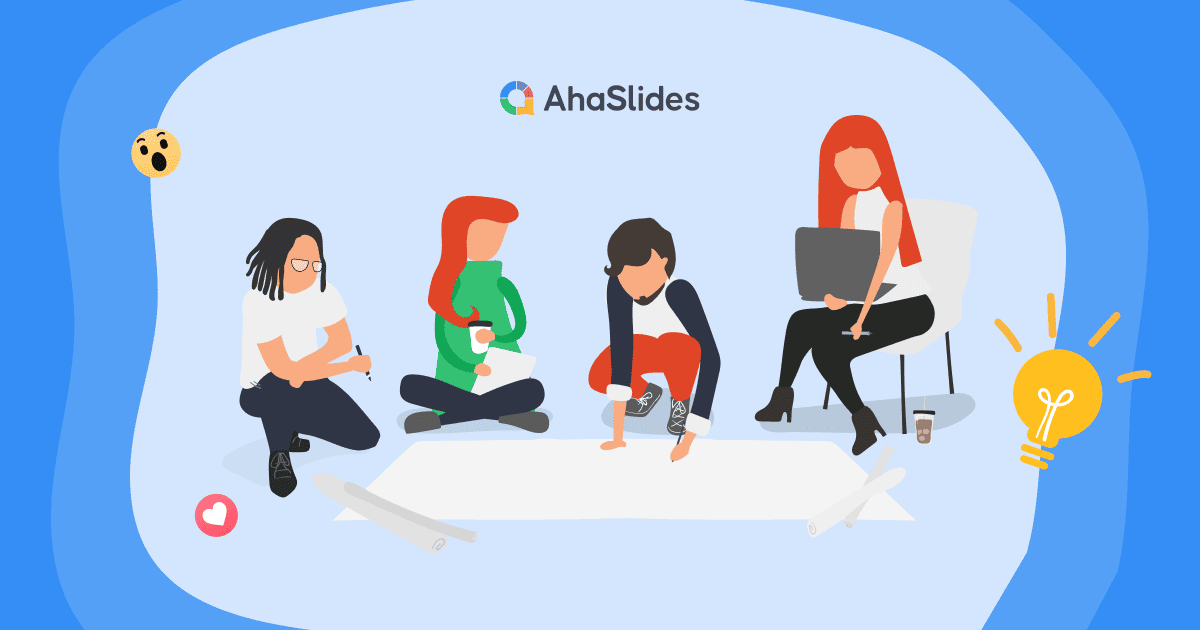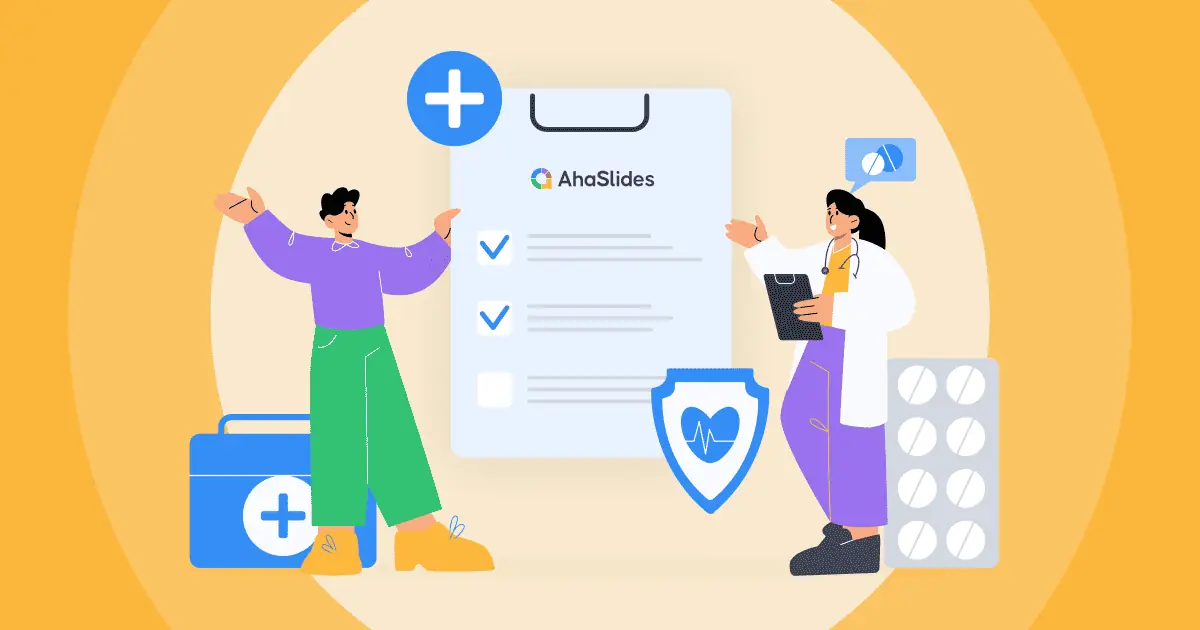Virtuele facilitering is er om te blijven, maar de overgang van face-to-face training naar virtuele training is vaak meer werk dan veel begeleiders zich realiseren.
Daarom passen we ons aan. Deze gids voor het hosten van een virtuele training uit 2022 bevat 17 tips en tools voor een soepele migratie van methoden. Hoe lang je ook al trainingen geeft, we weten zeker dat je iets nuttigs zult vinden in de onderstaande online trainingstips!
Gids voor online trainingstips
- Tip 1: maak een plan
- Tip #2: Houd een virtuele sessie
- Tip 3: neem regelmatig een pauze
- Tip # 4: Beheer uw tijd op microniveau
- Tip # 5: Breek het ijs
- Tip # 6: speel een paar games
- Tip # 7: laat ze het leren
- Tip # 8: gebruik re-enactment
- Tip # 9: volg de 10, 20, 30-regel
- Tip # 10: krijg visueel
- Tip # 11: praten, discussiëren, debatteren
- Tip # 12: maak een back-up
- Tip #13: Verzamel informatie
- Tip # 14: Ga naar de peilingen
- Tip # 15: wees open
- Tip # 16: Q & A-segment
- Tip # 17: doe een quiz
- Veelgestelde Vragen / FAQ
Tips voor een betere betrokkenheid
- Ultimate Training en ontwikkeling in HRM in 2024
- Beste ideeën om online te hosten HR-workshops in 2024
- Voorbeelden van trainingschecklists in 2024

Op zoek naar manieren om je team te trainen?
Verzamel je teamleden voor een leuke quiz op AhaSlides. Meld je aan voor een gratis quiz uit de sjablonenbibliotheek van AhaSlides!
🚀 Grijp gratis quiz☁️
Wat is virtuele training?
Simpel gezegd, virtuele training is training die online plaatsvindt, in tegenstelling tot face-to-face. De training kan vele digitale vormen aannemen, zoals een webinar, YouTube-stream of in-company videogesprek, waarbij al het leren, oefenen en testen plaatsvindt via videoconferenties en andere online tools.
Als virtuele facilitator, het is jouw taak om de training op koers te houden en de groep door de training te leiden. presentaties, discussies, casestudies en online activiteitenAls dat niet te veel verschilt van een gewone training, probeer het dan eens zonder fysieke hulpmiddelen en met een grote groep gezichten die je aanstaren!
Waarom virtuele training?
Afgezien van de voor de hand liggende pandemiebestendige bonussen, zijn er veel redenen waarom u in 2022 op zoek zou kunnen zijn naar virtuele training:
- Convenience – Virtuele training kan absoluut overal plaatsvinden met een internetverbinding. Thuis verbinding maken is gewoon oneindig veel beter dan een lange ochtendroutine en twee lange reistijden voor een fysieke training.
- Groen – Geen enkele milligram koolstofuitstoot!
- Goedkoop – Geen kamerhuur, geen maaltijden om te verzorgen en geen transportkosten.
- anonimiteit – Laat cursisten hun camera uitzetten en anoniem vragen beantwoorden. Zo neemt u alle angst voor een oordeel weg en draagt u bij aan een open en vloeiende trainingssessie.
- De toekomst – Nu werken steeds meer op afstand gebeurt, zal virtuele training steeds populairder worden. De voordelen zijn nu al te talrijk om te negeren!
Grootste aanpassingsuitdagingen in virtuele training
Hoewel virtuele training zowel jou als je cursisten veel voordelen kan bieden, verloopt de overgang zelden soepel. Houd deze uitdagingen en aanpassingsmethoden in gedachten totdat je zeker weet dat je online training kunt geven.
| Challenge | Hoe u zich kunt aanpassen |
|---|---|
| Geen fysieke materialen | Gebruik online tools die de tools die in face-to-face worden gebruikt, repliceren en verbeteren. |
| Geen fysieke aanwezigheid | Gebruik software voor videoconferenties, schermdeling en interactie om iedereen verbonden te houden. |
| Afleiding thuis | Geschikt voor het thuisleven met regelmatige pauzes en goed tijdbeheer. |
| Moeilijker om groepswerk te doen | Gebruik brainstormruimten om groepswerk te organiseren. |
| Zoomalgoritme geeft de voorkeur aan meer vocale luidsprekers | Gebruik Zoomchat, live polling en schriftelijke vragen om ervoor te zorgen dat iedereen een stem heeft. |
| Mogelijke softwareproblemen | Plan goed, test vooraf en zorg voor een backup! |
⏰ Tips voor het structureren
Virtuele training. Dingen interessant houden, vooral in de online ruimte, is echt niet eenvoudig. Het hebben van een betrouwbare structuur met een scala aan verschillende activiteiten maakt dingen zoveel gemakkelijker.
Tip 1: maak een plan
Het meest cruciale advies dat we kunnen geven voor een virtuele trainingssessie is om definieer uw structuur door middel van een plan. Uw plan is de solide basis van uw online sessie; het ding dat alles op het goede spoor houdt.
Als je al een tijdje traint, dan is dat geweldig, je hebt waarschijnlijk al een plan. Toch, de virtueel een deel van een virtuele trainingssessie kan leiden tot problemen die u in de offline wereld misschien niet hebt overwogen.
Begin met het opschrijven van vragen over uw sessie en welke acties u gaat ondernemen om ervoor te zorgen dat deze soepel verloopt:
| Contact | Acties |
|---|---|
| Wat wil ik precies dat mijn trainees leren? | Maak een lijst van de doelen die u aan het einde van de sessie wilt bereiken. |
| Wat ga ik gebruiken om het te leren? | Maak een lijst van de online tools die u zullen helpen de sessie te vergemakkelijken. |
| Welke lesmethode ga ik gebruiken? | Geef aan welke stijlen u wilt gebruiken om les te geven (discussie, rollenspel, lezing…) |
| Hoe ga ik hun leren evalueren? | Geef aan op welke manieren je hun begrip gaat testen (door bijvoorbeeld een quiz te doen, ze het zelf te laten leren...) |
| Wat ga ik doen bij technische problemen? | Maak een lijst van alternatieven voor uw online methodologie om verstoring in geval van problemen te minimaliseren. |

Zodra je dat hebt gedaan, plan je de structuur van je sessie aan de hand van de acties die je zojuist hebt genoemd. Schrijf voor elk onderdeel het belangrijkste leerpunt, de online tools die je gaat gebruiken, het tijdsbestek, hoe je het begrip gaat testen en wat je gaat doen als er een technisch probleem is.
Protip: Bekijk meer geweldige tips voor het plannen van een trainingsles op MindTools. comZe bieden zelfs een trainingslessjabloon dat u kunt downloaden, aanpassen aan uw eigen virtuele trainingssessie en delen met uw deelnemers, zodat zij weten wat er tijdens de sessie verwacht wordt.
Tip 2: houd een virtuele breakout-sessie
Het is altijd een goed idee om discussie tijdens virtuele trainingsactiviteiten aan te moedigen, vooral als je dit in kleine online groepen kunt doen.
Hoe productief een grootschalige discussie ook kan zijn, het houden van ten minste één 'breakout-sessie' (een handvol kleinschalige discussies in afzonderlijke groepen) kan heel nuttig zijn om de betrokkenheid te vergroten en begrip te testen.
Zoom Maakt tot 50 breakout-sessies in één vergadering mogelijk. Het is onwaarschijnlijk dat u alle 50 nodig zult hebben, tenzij u meer dan 100 mensen traint. Het is echter een goede toevoeging aan uw structuur om er een aantal te gebruiken om groepen van 3 of 4 deelnemers te vormen.
Hier volgen enkele tips voor uw virtuele break-outsessie:
- Flexibel zijn – Je cursisten zullen verschillende leerstijlen hebben. Probeer iedereen tegemoet te komen door flexibel te zijn en de deelnemers de mogelijkheid te geven om te kiezen uit een lijst met activiteiten. De lijst kan bijvoorbeeld bestaan uit het geven van een korte presentatie, het maken van een video, het naspelen van een scenario, enzovoort.
- Bied prijzen aan – Dit is een goede motivatie voor de minder enthousiaste deelnemers. De belofte van een aantal mystery-prijzen voor de beste presentatie/video/rollenspel lokt meestal meer en betere inzendingen uit.
- Maak een flink stuk tijd vrij – Tijd kan kostbaar zijn tijdens uw virtuele trainingssessie, maar de positieve aspecten van peer learning Er zijn er te veel om over het hoofd te zien. Besteed minstens 15 minuten aan voorbereiding en 5 minuten aan presentatie per groep; de kans is groot dat dit voldoende is om waardevolle inzichten uit je sessie te halen.
Tip 3: neem regelmatig een pauze
We hoeven op dit punt waarschijnlijk niet de voordelen van pauzes uit te leggen – het bewijs is overal.
Aandachtsplannen zijn vooral vluchtig in de online ruimte terwijl thuis trainen voor een hoop afleidingen zorgt die een virtuele sessie kunnen laten ontsporen. Korte, regelmatige pauzes laten deelnemers informatie verwerken en kunnen zich bezighouden met de noodzakelijke taken van hun privéleven.
Tip # 4: Beheer uw tijd op microniveau
Hoe licht en luchtig je ook wilt om de sfeer in je virtuele trainingssessie te behouden, er zijn momenten dat je dat nodig hebt koude, harde tijdmanagementvaardigheden om alles onder controle te houden.
Een van de hoofdzonden van trainingsseminars is de maar al te vaak voorkomende neiging om zo ongeveer voorbij te rennen elke tijd. Als de deelnemers aan uw trainingsseminar zelfs maar even moeten blijven, zult u merken dat er ongemakkelijk op stoelen wordt geschoven en dat er vluchtig naar de klok wordt gekeken.

Probeer deze tips om uw timing goed te krijgen:
- Set realistische tijdframes voor elke activiteit.
- Doe een oefenrondje met familie / vrienden om te zien hoe lang secties duren.
- Verander regelmatig secties – online is de aandachtsspanne korter.
- Altijd blijf bij de tijd die u toewijst voor elke sectie en houd je aan de tijd die je bent toegewezen voor uw seminarie!
Als een sectie heeft Om te overlopen, moet je een later gedeelte in gedachten hebben dat je kunt inkorten. En als je bijna aan het eind bent en er nog 30 minuten over zijn, zorg dan dat je wat tijdvullers achter de hand hebt om de gaten te vullen.
🏄♂️ Virtuele training – Activiteitentips
Na al het presenteren van jouw kant (en zeker ook daarvoor) zul je je trainees zover moeten krijgen dat ze: dingen doenActiviteiten helpen niet alleen om trainingen in de praktijk te brengen, maar ook om stagiairs te helpen te leren, maar ze helpen ook om de informatie te verstevigen en te behouden uit het hoofd geleerd voor langer.
Tip # 5: Breek het ijs
We weten zeker dat je zelf wel eens een online call-in hebt bijgewoond en dringend behoefte had aan een ijsbreker. Grote groepen en nieuwe technologie zorgen voor onzekerheid over wie er moet spreken en aan wie het Zoom-algoritme een stem zal geven.
Daarom is het belangrijk om met een ijsbreker te beginnen cruciaal voor het vroege succes van een virtuele trainingssessie. Het laat iedereen aan het woord, leert meer over zijn medebezoekers en vergroot hun zelfvertrouwen voorafgaand aan het hoofdgerecht.
Hier zijn een paar ijsbrekers die u gratis kunt proberen:
- Deel een gênant verhaal – Niet alleen zorgt dit ervoor dat de deelnemers al beginnen te schateren, maar het is bewezen om ze open te stellen, ze meer betrokken te krijgen en ze aan te moedigen om later met betere ideeën te komen. Elke persoon schrijft een korte paragraaf op en kiest ervoor om deze anoniem te houden of niet, waarna de gastheer ze voorleest aan de groep. Simpel, maar duivels effectief.
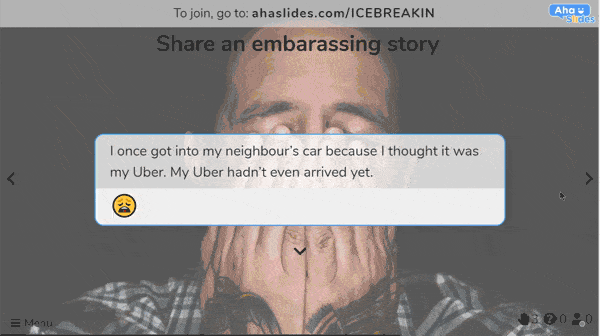
- Waar kom jij vandaan? – Deze is gebaseerd op de geografische affiniteit die twee mensen bereiken wanneer ze zich realiseren dat ze van dezelfde plek komen. Vraag je deelnemers simpelweg waar ze zich aanmelden en onthul de resultaten in één groot scherm. word cloud aan het einde.
⭐ Je vindt laadt meer virtuele ijsbrekers door hier te klikkenWij vinden het persoonlijk geweldig om onze virtuele vergaderingen meteen goed te beginnen met een ijsbreker, en er is geen reden waarom jij dat niet zou doen!
Tip # 6: speel een paar games
Virtuele trainingssessies hoeven (en zouden zeker niet moeten) een stortvloed aan saaie, vergeetbare informatie te zijn. Het zijn grote kansen voor sommigen. teambinding spellen; tenslotte, hoe vaak gaat u al uw personeel samen in dezelfde virtuele ruimte krijgen?
Door tijdens de sessie een aantal spelletjes te spelen, blijft iedereen wakker en kan de geleerde informatie beter worden geconsolideerd.
Hier zijn een paar spellen die u kunt aanpassen aan virtuele training:
- Gevaar – Gebruik maken van de gratis service jeopardylabs.comJe kunt een Jeopardy-bord maken op basis van het onderwerp dat je behandelt. Maak simpelweg 5 of meer categorieën en 5 of meer vragen voor elke categorie, waarbij de vragen steeds moeilijker worden. Verdeel je deelnemers in teams om te zien wie de meeste punten verzamelt!
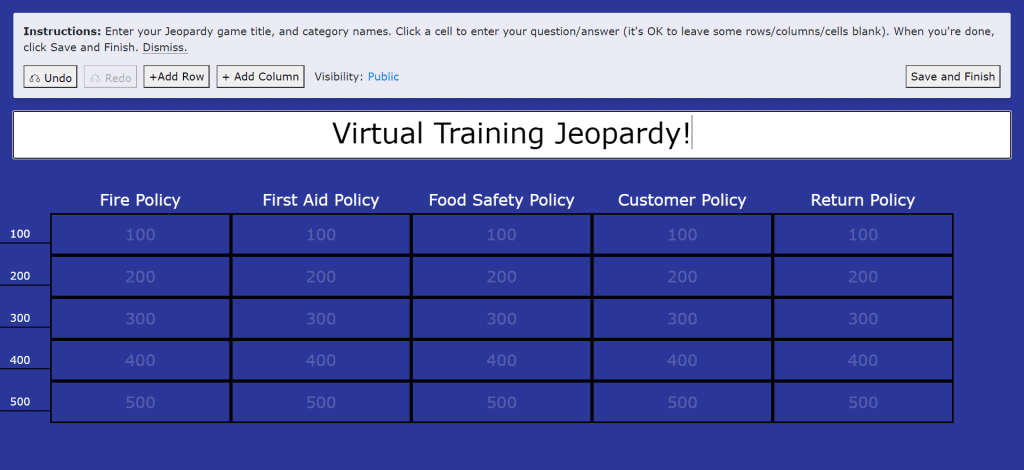
2. Fictionary / Balderdash – Geef een stukje terminologie dat je net hebt geleerd en vraag je spelers om de juiste betekenis van het woord te geven. Dit kan een open vraag zijn of een meerkeuzevraag als het een lastige vraag is.
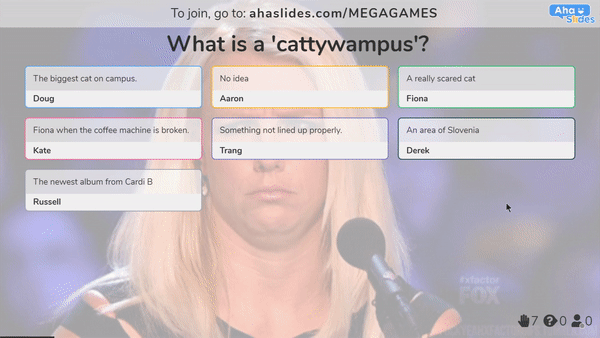
⭐ We hebben hier nog een heleboel games voor je. U kunt alles in de lijst aanpassen aan het onderwerp van uw virtuele training en zelfs prijzen voor de winnaars toevoegen.
Tip # 7: laat ze het leren
Het is een geweldige manier om leerlingen iets te laten onderwijzen wat ze net hebben geleerd. cementeer die informatie in hun gedachten.
Moedig cursisten aan om na een megagedeelte van uw virtuele trainingssessie vrijwilligerswerk te doen om de belangrijkste punten samen te vatten voor de rest van de groep. Dit kan zo lang of kort zijn als ze willen, maar het belangrijkste doel is om de hoofdpunten te doorgronden.

Er zijn een paar manieren om dit te doen:
- Deel deelnemers op in virtuele ontsnappingsgroepen, geef ze bepaalde aspecten van de informatie, vat ze samen en geef ze 15 minuten om er een presentatie over te geven.
- Vraag vrijwilligers De belangrijkste punten samenvatten zonder voorbereidingstijd. Dit is een ruwere aanpak, maar een nauwkeurigere test van iemands begrip.
Na afloop kun je aan de rest van de groep vragen of de vrijwillige leerkracht iets gemist heeft, of je vult gewoon zelf de gaten in.
Tip # 8: gebruik re-enactment
We proberen hier bewust het woord 'rollenspel' te vermijden. Iedereen vreest het noodzakelijke kwaad van rollenspel, maar 'heropvoering' geeft er een aantrekkelijkere draai aan.
Bij een re-enactment geef je je groepen trainees meer controle. Jij laat aan hen kies wat voor soort situatie ze willen naspelen, wie welke rol wil spelen en welke toon de re-enactment precies zal aannemen.

U kunt dit op de volgende manier online doen:
- Zet je bezoekers in breakout groepen.
- Geef ze een paar minuten de tijd om met elkaar te praten over een situatie die ze graag willen naspelen.
- Geef ze een bepaalde hoeveelheid tijd om het script en de acties te perfectioneren.
- Breng elke ontsnappingsgroep terug naar de hoofdruimte om op te treden.
- Bespreek openlijk wat elke groep goed deed en hoe elke groep zou kunnen verbeteren.
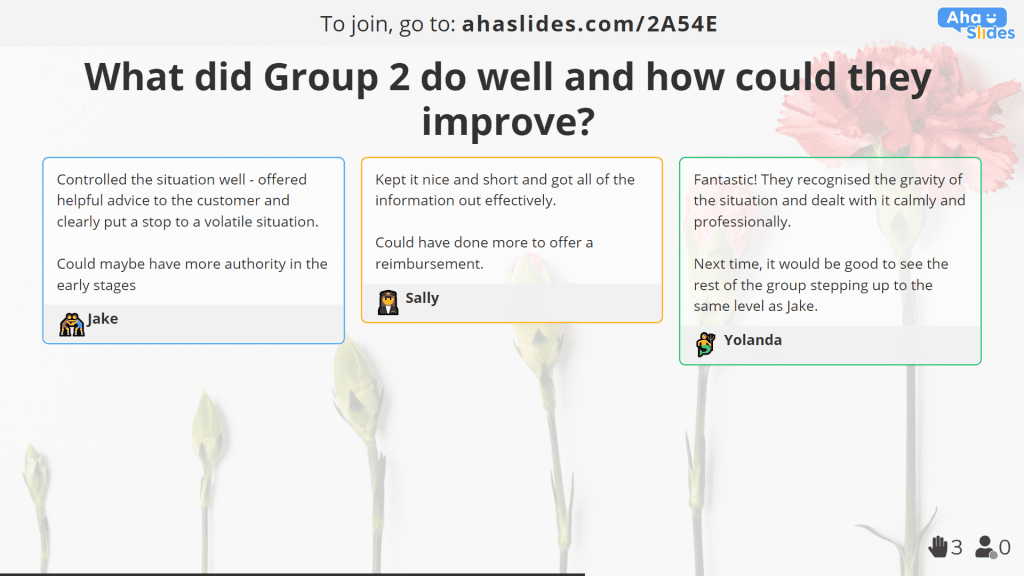
Meer controle bieden leidt vaak tot meer betrokkenheid en meer inzet voor wat traditioneel gezien wordt als het slechtste onderdeel van elke trainingssessie. Het geeft iedereen een rol en situatie waar hij of zij zich prettig bij voelt en kan daarom enorm bijdragen aan de ontwikkeling.
📊 Presentatietips
Bij een virtuele trainingssessie zit de camera stevig vast helpen Het maakt niet uit hoeveel fantastisch groepswerk je doet, al je bezoekers zullen naar je kijken, en de informatie die je presenteert, voor begeleiding. Uw presentaties moeten dus krachtig en effectief zijn. Presenteren aan gezichten via camera's, in plaats van aan mensen in kamers, is een heel ander spel.
Tip # 9: volg de 10, 20, 30-regel
Denk niet dat uw deelnemers een abnormaal korte aandachtsspanne hebben. Overmatig gebruik van PowerPoint leidt tot een zeer reële plaag genaamd Dood door Powerpoint, en het beïnvloedt elke dia-viewer, niet alleen marketingmanagers.
Het beste tegengif hiervoor is Guy Kawasaki's 10, 20, 30 regerenHet principe is dat presentaties niet langer mogen zijn dan 10 dia's, niet langer mogen duren dan 20 minuten en dat het lettertype niet kleiner mag zijn dan 30 punten.
Waarom de 10, 20, 30-regel gebruiken?
- Hogere betrokkenheid – De aandachtsspanne is meestal nog kleiner in de online wereld, dus het is nog belangrijker om jezelf vast te leggen op een 10, 20, 30 presentatie.
- Minder onzin – Als de nadruk ligt op de informatie die echt nodig is, voorkomt u dat deelnemers in de war raken door zaken die er niet echt toe doen.
- Meer memorabel – De combinatie van de twee voorgaande punten resulteert in een krachtige presentatie die lang in het geheugen blijft hangen.
Tip # 10: krijg visueel
Er is eigenlijk maar één reden waarom iemand alleen maar tekst in plaats van beeldmateriaal zou kunnen gebruiken: luiheidHet is keer op keer bewezen dat visuele content de beste manier is om de aandacht van uw publiek te trekken en hun geheugen voor uw informatie te stimuleren.
- Het publiek leest 30 keer meer een goede infographic dan platte tekst. (KISSmetrics)
- Instructies via visuele media, in plaats van platte tekst, kunnen 323% duidelijker zijn. (Springer Link)
- Door wetenschappelijke claims in eenvoudige grafieken te zetten, kan hun geloofwaardigheid onder mensen toenemen van 68% tot 97% (Cornell University)
We kunnen nog wel even doorgaan, maar we hebben ons punt waarschijnlijk wel duidelijk gemaakt. Visuele informatie maakt je informatie aantrekkelijker, duidelijker en betrouwbaarder.

We hebben het hier niet alleen over grafieken, peilingen en diagrammen. visuals bevat alle afbeeldingen of video's die de ogen een pauze geven van muren met tekst, die punten veel beter kunnen illustreren dan woorden.
In feite is het in een virtuele trainingssessie nog gemakkelijker om gebruik te maken van beeldmateriaal. Je kunt concepten en situaties ook weergeven met behulp van rekwisieten boven je camera, zoals...
- Een situatie om op te lossen (bijvoorbeeld twee poppen die ruzie maken).
- Een te volgen veiligheidsprotocol (bijv. Een gebroken glas op een tafel).
- Een ethisch punt om te maken (bijv. een zwerm muggen loslaten om een verklaring af te leggen over malaria).
Tip # 11: praten, discussiëren, debatteren
We hebben allemaal wel eens presentaties gehad waarbij de presentator simpelweg de tekst van zijn presentatie voorleest zonder er iets aan toe te voegen. Ze doen het omdat... Het is gemakkelijker om je achter technologie te verschuilen dan om improviserend inzicht te bieden.
Het is dan ook begrijpelijk waarom virtuele facilitators de voorkeur geven aan een groot aantal online tools. Ze zijn immers heel eenvoudig in te stellen en uit te voeren, toch?
Nou, zoals alles in een virtuele trainingssessie, het is gemakkelijk om het te overdrijvenVergeet niet dat goede presentaties niet zomaar een waterval van woorden op een scherm zijn. Het zijn levendige discussies en boeiende debatten waarin veel verschillende perspectieven aan bod komen.

Hier zijn een paar kleine tips om uw presentatie verbaal te maken…
- Pauzeer regelmatig om een open vraag te stellen.
- Aanmoedigen controversiële perspectieven (u kunt dit doen via een anonieme presentatiedia).
- Vraag ernaar voorbeelden van situaties uit het echte leven en hoe deze zijn opgelost.
Tip # 12: maak een back-up
Hoewel moderne technologie ons leven en onze trainingssessies verbetert, is het geen absolute garantie.
Plannen maken voor een volledig softwarefalen lijkt misschien pessimistisch, maar het is ook onderdeel van een solide strategie dat zorgt ervoor dat uw sessie zonder problemen kan verlopen.

Voor elk hulpmiddel voor online training is het goed om er één of twee extra te hebben die, indien nodig, te hulp kunnen schieten. Dat geldt ook voor jouw…
- Software voor videoconferenties
- Interactie software
- Live polling-software
- Quiz-software
- Online whiteboardsoftware
- Software voor het delen van video's
We hebben een aantal geweldige gratis tools voor deze taken op een rijtje gezet HieronderEr zijn voor beide opties voldoende alternatieven beschikbaar, dus doe wat onderzoek en maak back-ups!
👫 Interactie tips
We zijn veel verder gegaan dan de eenzijdige collegestijl van vroeger; de moderne, virtuele trainingssessie is een tweeweg dialoog dat houdt het publiek overal betrokken. Interactieve presentaties leiden tot een beter geheugen van de stof en een meer persoonlijke benadering.
Opmerking ⭐ De 5 onderstaande tips zijn allemaal op gemaakt AhaDia's, een gratis stuk software voor presentaties, enquêtes en quizzen dat is gespecialiseerd in interactiviteit. Alle antwoorden op vragen zijn ingediend door deelnemers aan een live evenement.
Tip # 13: Verzamel informatie via woordwolken
Als u op zoek bent naar korte, snelle reacties, live woordwolken zijn de weg te gaan. Door te kijken welke woorden het meest opduiken en welke woorden aansluiten bij wat anderen, kun je een betrouwbaar totaalbeeld krijgen van je cursisten.
Een woordwolk werkt in principe als volgt:
- U stelt een vraag waarop een antwoord van één of twee woorden wordt gevraagd.
- Uw publiek legt hun woorden voor.
- Alle woorden worden in een kleurrijke 'wolk'-formatie op het scherm weergegeven.
- De woorden met de grootste tekst waren de meest populaire inzendingen.
- Hoe minder woorden er worden ingezonden, hoe kleiner ze worden.
Hier is een geweldig voorbeeld dat u aan het begin van (of zelfs vóór) uw sessie kunt gebruiken:
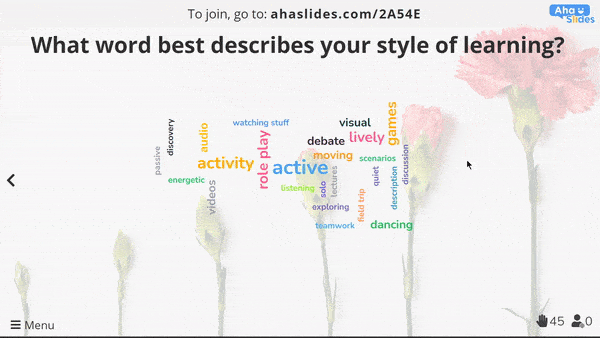
Dit soort vragen in een woordwolkdia kunnen je helpen om de meeste leerstijlen binnen je groep gemakkelijk te visualiseren. Woorden als 'actieve''activiteit'en'levendig' omdat de meest voorkomende antwoorden u laten zien dat u moet streven naar activiteiten en discussies die gebaseerd zijn op dingen doen.
Protip : Je kunt op het populairste woord in het midden klikken om het te verwijderen. Het wordt vervangen door het op één na populairste woord, zodat je altijd de populariteitsrangschikking tussen de antwoorden kunt zien.
Tip # 14: Ga naar de peilingen
We hebben al eerder gezegd dat beelden aantrekkelijk zijn, maar ze zijn nog meer boeiend als de visuals door het publiek zelf worden ingediend.
Hoe? Nou, het houden van een poll geeft je bezoekers een kans om visualiseren hun eigen gegevens. Het laat hen hun mening of resultaten zien in relatie tot anderen, allemaal in een kleurrijke grafiek die zich onderscheidt van de rest.
Hier zijn een paar ideeën voor opiniepeilingen die u zou kunnen gebruiken:
- Wat is het eerste dat je zou doen in deze situatie? (Meerkeuze)
- Welke van deze zijn volgens u het grootste brandgevaar? (Afbeelding meerkeuze)
- Hoe goed zou uw werkplek volgens u deze aspecten van veilige voedselbereiding faciliteren? (Schaal)
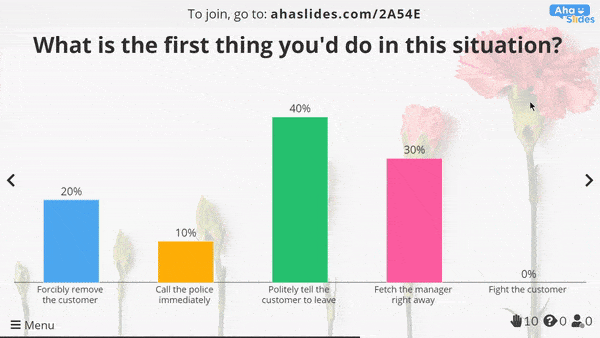
Gesloten vragen zoals deze zijn geweldig om kwantitatieve gegevens uit je groep te halen. Ze helpen je gemakkelijk te visualiseren wat je wilt meten en kunnen in een grafiek worden gezet, voor jou en je deelnemers.
Tip # 15: wees open
Hoe goed gesloten vragen ook kunnen zijn voor eenvoudige, snelle gegevensverzameling, het loont echt om dat te zijn open einde in uw opiniepeiling.
We hebben het over vragen die niet met een stemming of een simpel 'ja' of 'nee' beantwoord kunnen worden. Open vragen stimuleren een doordachter, persoonlijker antwoord en kunnen de katalysator zijn voor een langer en vruchtbaarder gesprek.
Probeer deze open vragen bij het hosten van uw volgende virtuele trainingssessie:
- Wat wil je uit deze sessie halen?
- Welk onderwerp wil je vandaag het liefst bespreken?
- Wat is de grootste uitdaging voor u op de werkvloer?
- Als u een klant was, hoe zou u dan verwachten in het restaurant behandeld te worden?
- Hoe denk je dat deze sessie is verlopen?
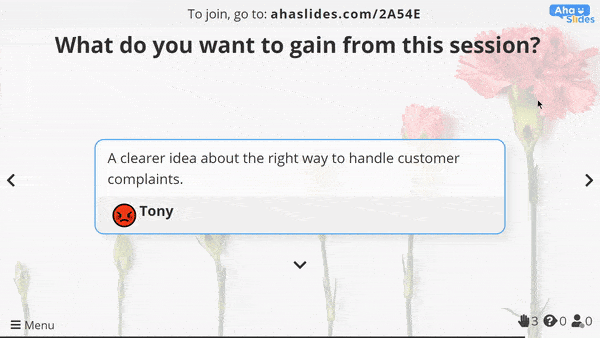
Tip # 16: Q & A-segment
Op een bepaald moment tijdens de virtuele trainingssessie moet u wat tijd vrijmaken voor uw deelnemers om te quizzen helpen.
Dit is een geweldige kans om de zorgen van uw stagiaires direct aan te pakken. Een Q & A-segment is niet alleen handig voor degenen die erom vragen, maar ook voor degenen die luisteren.
| Protip : Zoom kan mensen die vragen stellen geen anonimiteit bieden, hoewel anonimiteit een zekere manier is om meer vragen te krijgen. Met gratis software zoals AhaSlides kun je de identiteit van je publiek verbergen en zo meer betrokkenheid bij je vraag-en-antwoordsessies stimuleren. |
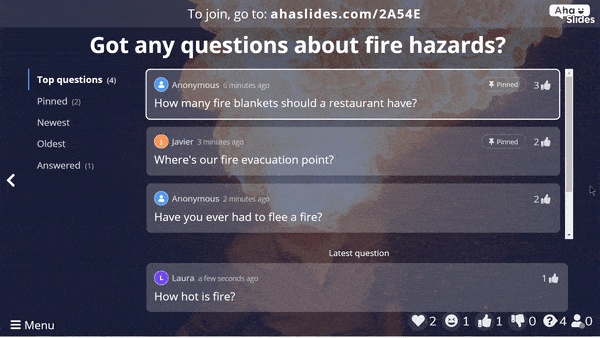
Een Q & A-dia voegt niet alleen anonimiteit toe, het helpt u ook om uw Q & A-sessie op een aantal manieren geordend te houden:
- Deelnemers kunnen hun vragen aan u voorleggen en vervolgens de vragen van anderen die ze graag beantwoord willen zien, een 'goedkeuring' geven.
- U kunt de vragen chronologisch of op populariteit rangschikken.
- U kunt belangrijke vragen vastzetten die u later wilt beantwoorden.
- U kunt vragen markeren als beantwoord, zodat ze naar het tabblad 'Beantwoord' worden gestuurd.
Tip # 17: doe een quiz
Het stellen van vraag na vraag kan snel vervelend worden. Het gooien van een quiz zorgt er echter voor dat het bloed gaat pompen en een virtuele trainingssessie opleeft als niets anders. Het bevordert ook gezonde concurrentie, welke is bewezen om het niveau van motivatie en energie te verhogen.
Een korte quiz is een fantastische manier om te testen in hoeverre je de informatie die je hebt gegeven begrijpt. We raden aan om na elk belangrijk onderdeel van je online training een korte quiz te houden om te controleren of je deelnemers het helemaal begrijpen.
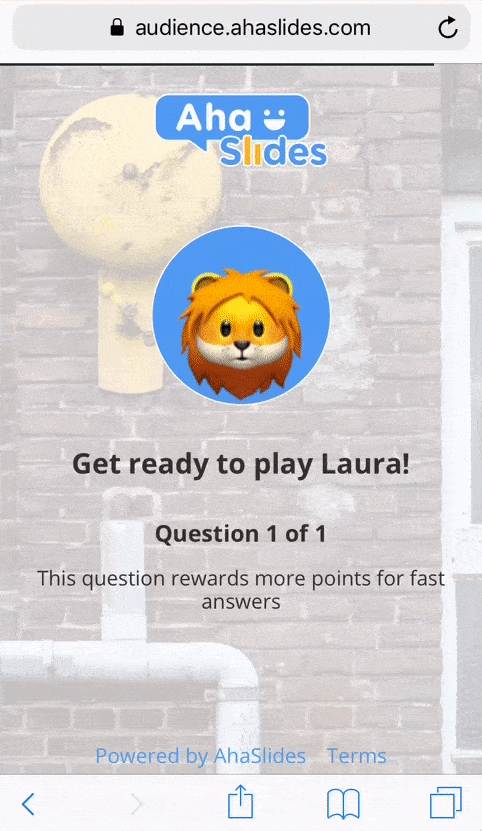
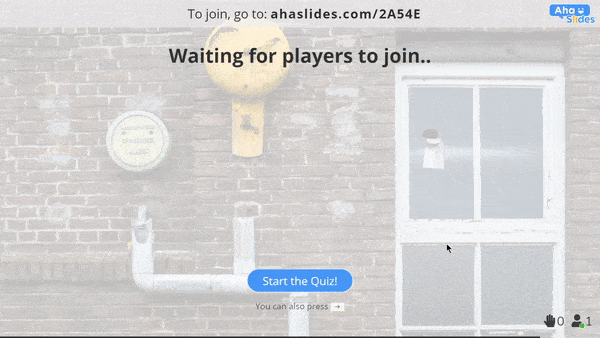
Bekijk deze ideeën voor het houden van een quiz die de aandacht trekt en informatie consolideert:
- Meerkeuzevragen – Deze snelvuurvragen zijn geweldig om het begrip van scenario's met ondubbelzinnige antwoorden te controleren.
- Typ antwoord – Een lastigere versie van meerkeuzevragen. 'Type antwoord'-vragen bieden geen lijst met antwoorden waaruit gekozen kan worden; ze vereisen dat uw deelnemers echt opletten, niet alleen maar gokken.
- Audio - Er zijn een paar superhandige manieren om audio in een quiz te gebruiken. Een daarvan is om een argument te simuleren en de aanwezigen te vragen hoe ze zouden reageren, of zelfs om audio-gevaren af te spelen en de aanwezigen te vragen de gevaren op te sporen.
Gratis tools voor virtuele training

Als u een virtuele trainingssessie wilt organiseren, kunt u er zeker van zijn dat er nu enorm veel gereedschap beschikbaar voor jou. Hier zijn een paar gratis versies die u zullen helpen bij het migreren van offline naar online.
Miro – Een virtueel whiteboard waarop u concepten kunt illustreren, stroomdiagrammen kunt maken, plaknotities kunt beheren, enz. Uw cursisten kunnen ook bijdragen, hetzij op een ander whiteboard of op hetzelfde whiteboard dat u gebruikt.
Hulpmiddelen voor geest – Geweldig advies over lesplannen, met een downloadbare sjabloon.
Bekijk2Gether – Een hulpmiddel dat video’s synchroniseert via verschillende verbindingen, waardoor iedereen in uw groep tegelijkertijd een instructie- of trainingsvideo kan bekijken.
Zoom/Microsoft Teams – Natuurlijk zijn dit de twee beste oplossingen voor het hosten van een virtuele trainingssessie. Beide zijn gratis te gebruiken (hoewel ze hun eigen beperkingen hebben) en beide bieden de mogelijkheid om breakout rooms te creëren voor kleinere groepsactiviteiten.
AhaDia's – Een tool waarmee je interactieve presentaties, polls, quizzen, games en meer kunt maken. Je kunt een presentatie maken met de gebruiksvriendelijke editor, er poll- of quizdia's aan toevoegen en vervolgens zien hoe je publiek reageert of presteert op hun telefoon.
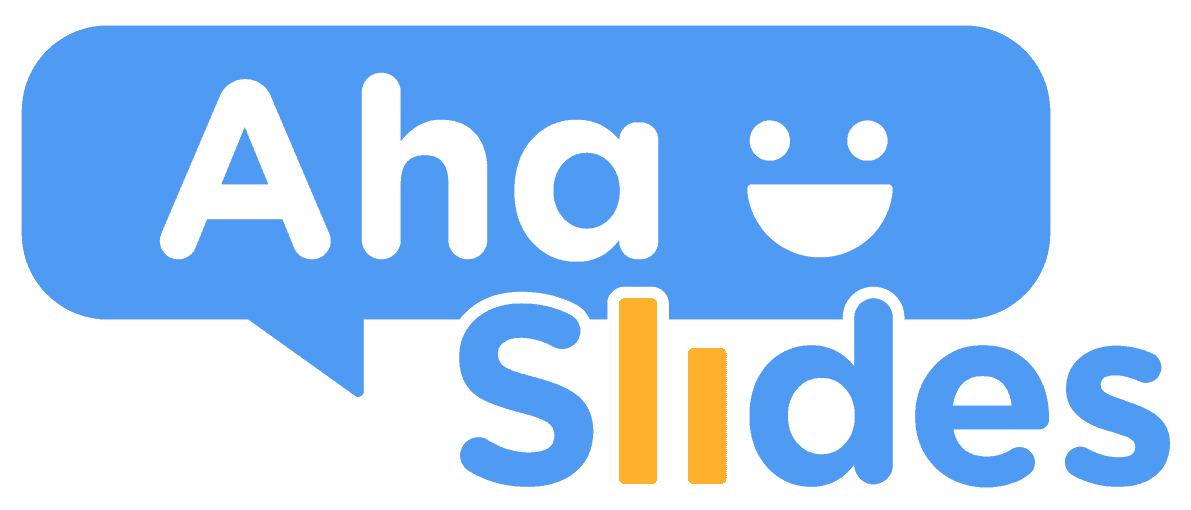
Sluit je aan bij honderdduizenden presentatoren, trainers en quizzers op interactieve software
Probeer het gratis!
Hoofdafbeelding met dank aan de Britse Veiligheidsraad
Veelgestelde Vragen / FAQ
Wat is virtuele training?
Virtuele training is een training die online plaatsvindt, in tegenstelling tot een fysieke training. De training kan vele digitale vormen aannemen, zoals een webinar, YouTube-stream of in-company videogesprek, waarbij al het leren, oefenen en testen plaatsvindt via videoconferenties en andere online tools.
Wat doet Virtual Trainer?
Als virtuele facilitator, het is jouw taak om de training op koers te houden en de groep door de training te leiden. presentaties, discussies, casestudies en online activiteitenAls dat niet te veel verschilt van een gewone training, probeer het dan eens zonder fysieke hulpmiddelen en met een grote groep gezichten die je aanstaren!
Waarom is virtuele training belangrijk?
Convenience – Virtuele training kan absoluut overal plaatsvinden met een internetverbinding. Thuis verbinding maken is gewoon oneindig veel beter dan een lange ochtendroutine en twee lange reistijden voor een fysieke training.
Groen – Geen enkele milligram koolstofuitstoot!
Goedkoop – Geen kamerhuur, geen maaltijden om te verzorgen en geen transportkosten.
anonimiteit – Laat cursisten hun camera uitzetten en anoniem vragen beantwoorden. Zo neemt u alle angst voor een oordeel weg en draagt u bij aan een open en vloeiende trainingssessie.
De toekomst – Nu werken steeds meer op afstand gebeurt, zal virtuele training steeds populairder worden. De voordelen zijn nu al te talrijk om te negeren!
Wat zijn voorbeelden van best practices voor virtuele facilitering?
Voorafgaand aan de sessies moeten de trainers onderzoek doen met behulp van trendy hulpmiddelen en technieken, zodat ze op de hoogte zijn van het meest recente nieuws. Deze informatie is namelijk zeer nuttig voor de deelnemers!

